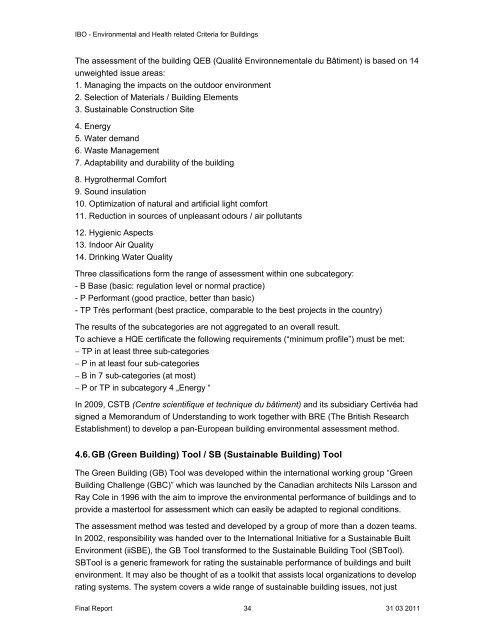Environmental and health related criteria for buildings - ANEC
Environmental and health related criteria for buildings - ANEC
Environmental and health related criteria for buildings - ANEC
You also want an ePaper? Increase the reach of your titles
YUMPU automatically turns print PDFs into web optimized ePapers that Google loves.
IBO - <strong>Environmental</strong> <strong>and</strong> Health <strong>related</strong> Criteria <strong>for</strong> Buildings<br />
The assessment of the building QEB (Qualité Environnementale du Bâtiment) is based on 14<br />
unweighted issue areas:<br />
1. Managing the impacts on the outdoor environment<br />
2. Selection of Materials / Building Elements<br />
3. Sustainable Construction Site<br />
4. Energy<br />
5. Water dem<strong>and</strong><br />
6. Waste Management<br />
7. Adaptability <strong>and</strong> durability of the building<br />
8. Hygrothermal Com<strong>for</strong>t<br />
9. Sound insulation<br />
10. Optimization of natural <strong>and</strong> artificial light com<strong>for</strong>t<br />
11. Reduction in sources of unpleasant odours / air pollutants<br />
12. Hygienic Aspects<br />
13. Indoor Air Quality<br />
14. Drinking Water Quality<br />
Three classifications <strong>for</strong>m the range of assessment within one subcategory:<br />
- B Base (basic: regulation level or normal practice)<br />
- P Per<strong>for</strong>mant (good practice, better than basic)<br />
- TP Très per<strong>for</strong>mant (best practice, comparable to the best projects in the country)<br />
The results of the subcategories are not aggregated to an overall result.<br />
To achieve a HQE certificate the following requirements (“minimum profile”) must be met:<br />
− TP in at least three sub-categories<br />
− P in at least four sub-categories<br />
− B in 7 sub-categories (at most)<br />
− P or TP in subcategory 4 „Energy “<br />
In 2009, CSTB (Centre scientifique et technique du bâtiment) <strong>and</strong> its subsidiary Certivéa had<br />
signed a Memor<strong>and</strong>um of Underst<strong>and</strong>ing to work together with BRE (The British Research<br />
Establishment) to develop a pan-European building environmental assessment method.<br />
4.6. GB (Green Building) Tool / SB (Sustainable Building) Tool<br />
The Green Building (GB) Tool was developed within the international working group “Green<br />
Building Challenge (GBC)” which was launched by the Canadian architects Nils Larsson <strong>and</strong><br />
Ray Cole in 1996 with the aim to improve the environmental per<strong>for</strong>mance of <strong>buildings</strong> <strong>and</strong> to<br />
provide a mastertool <strong>for</strong> assessment which can easily be adapted to regional conditions.<br />
The assessment method was tested <strong>and</strong> developed by a group of more than a dozen teams.<br />
In 2002, responsibility was h<strong>and</strong>ed over to the International Initiative <strong>for</strong> a Sustainable Built<br />
Environment (iiSBE), the GB Tool trans<strong>for</strong>med to the Sustainable Building Tool (SBTool).<br />
SBTool is a generic framework <strong>for</strong> rating the sustainable per<strong>for</strong>mance of <strong>buildings</strong> <strong>and</strong> built<br />
environment. It may also be thought of as a toolkit that assists local organizations to develop<br />
rating systems. The system covers a wide range of sustainable building issues, not just<br />
Final Report 34 31 03 2011
















